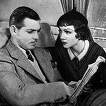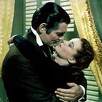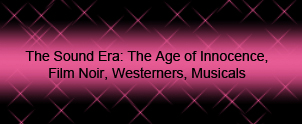











We divide this period into several categories. First, the movies that straddle the silent era. The most famous being the Jazz Singer with Al Jolson. It was mostly a silent movie with some song and dance included as an after thought. It was a resounding success. Many studios did not believe that sound would stay as a medium and as a result, they eventually vanished. The great Keystone and Mutual studios did not survive the sound era. Many actors could not compete in the new medium because their voices were too high pitched or had very thick accents. The sound system accentuated these characteristics. Even the great Charlie Chaplin did not make many great sound movies. Most of his best full-length movies and shorts were either silent or silent/mono. The best example being the Gold Rush (1925) and City Lights (1931). His best sound movie is probably the Great Dictator (1940) which infuriated Hitler no end. Cecile B. De Mille, on the other hand, adapted very quickly to the new format and made his best movies during this era. New directors and producers arrived on the scene. Probably the best example is Frank Capra, a man with boundless optimism and belief in the goodness of man and greatness of America. Films such as It Happened One Night (1934), Mr. Smith Goes to Washington (1939), Meet John Doe (1941) and of course the perennial It Is a Wonderful Life (1946), innocent and full of hope for tomorrow! In Mr. Smith Goes to Washington, James Stewart plays an inexperienced lawmaker who goes to Washington with high principles. He is soon disheartened by the greed and corruption of politics. Things have not changed much since the Thirties have they? |
||||||||||
|
Film Noir was probably invented by the French and copied by the American studios. There are several descriptions for Film Noir. Generally, these were low budget movies and were shot in Black and White. They usually were only a few actors involved in the movie and plot was engaging yet depressing. They always had a dark side to them and inevitably had unhappy endings. Think of the Maltese Falcon, Casablanca, Double Indemnity, the Big Sleep and even Citizen Kane. They all had the same attributes. Humphrey Bogart, James Cagney, Edward G. Robinson, Barbara Stanwyck and the underappreciated George Raft were some of the great actors who made their marks in these movies. John Houston and Billy Wilder are among the great directors in this category. The other category was the Westerns. The singing cowboys such as Gene Autry and Roy Rogers packed the movie houses with fans and the sound of bullets and charging Indians accompanied by the drums and music that implied impending doom put the viewers on edge. There were actually two types of Westerns. The first type involved the eternal battle of good and evil set in western surroundings. A cattle baron is trying to evict the poor homesteaders. He happens to have a beautiful daughter. Then there is a heroic newcomer who battles the forces of evil. He saves the day and marries the girl. There is usually, a bar floozy with a heart of gold who falls in love with our hero. Hundred of movies were made following the same formula with some variations. These films were actually modern day dramas transported back in time. In fact, many of them were planned as contemporary dramas but were changed into the Western format because the wardrobe department did not have any contemporary costumes at the time of shooting. The other category, which I would call genuine westerns, were the one's involving historical events such as Geronimo's stand, the Apaches and Sioux wars and the wagon train stories of our ancestors crossing the hostile land from Missouri to California and a new life. The most famous Western actors were Randolph Scott, Gary Cooper, John Wayne and Glenn Ford. In mid forties, the subject of racism made it to the big screens. Films such as the Gentlemen's Agreement (1947) by Elia Kazan with Gregory Peck and John Garfield and Lost Boundaries (1949) by Louis de Rochemont with Mel Ferrer playing a black doctor passing as white helped as a wakeup call to the nation. The Best Years of Our Lives (1946) directed by William Wyler actually starred the disabled veteran Harold Russell in one of the title roles. It also broached the subject of adultery by a married woman. Steve Cochrane cuckolds Dana Andrews and he actually accepts it and moves on to fall in love with Teresa Wright, the very young daughter of his friend Fredric March. The subject had been taboo for years. In 1930 just after the passage of the movies Production Code, in Divorcee Norma Shearer played a young wife who commits adultery with her husband's best friend. She also played a similar role in Riptide (1936.) Later on, married American women were generally put on a pedestal and treated as virtuous and unincorruptible. Until the sixties, this personification was not far from the truth. The musicals took off in the 1930's and they got better and more extravagant as time went on. There was the great Busby Berkeley and his superbly choreographed dance numbers. The original 42 nd Street made in 1933 is probably one of his best works if not the best. Yankee Doodle Dandee with James Cagney was another masterpiece. The trend continued with movies such as Singing in the Rain and An American in Paris and probably ended with the Seven Brides for Seven Brothers in 1954 that very effectively used the new medium of Cinemascope and Stereophonic sound. Towards the end of this period, television replaced the movies as the primary means of entertainment for the American Families. Most movie studios went broke and they had to sell off all their assets. To counter the threat of the small screen, the movie studios first tried making 3D movies that required the viewers to wear glasses during the screening. When that did not work out, Fox Studios purchased the rights to the Cinemascope lens from a French inventor and Paramount developed VistaVision. Movie theaters were refitted with wide screens and stereophonic sound systems were installed. Black and White movies were all but abandoned in favor of color. New coloring techniques were developed to replace the venerable Technicolor. New tints such as Deluxe Color, Cine Color, Super Cine Color and Ferrania Color were introduced with the wide screen. These innovations slowed down the hemorrhaging somewhat but could not save United Artist, Republic, RKO and even MGM. They either folded or became part of conglomerates. Some of the other wonderful movies made during this period are: Gone with the Wind |